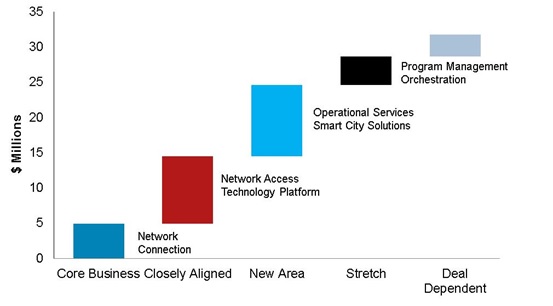































Tremendous new opportunities are being created for technology vendors and service providers as cities around the world look to build out smart cities to reduce municipal costs, tap new sources of revenue, and improve the overall quality of urban life. The previous blog (Smart Cities Are a$7.5 Billion Annual Opportunity for Technology Providers) described all of the essential requirements of the smart city architecture and quantified the great opportunities for technology vendors and partners to help to create and operate these digitally smart cities of the future. The last question to address is what are the specific opportunities for SPs and where should they play to extract the most value from the deployment of smart cities?
The potential revenue opportunities available to SPs depend upon the strategic fit to their business. Specifically, we evaluated the opportunities across three strategic fit criteria:
Assessing the smart city revenue opportunities across these criteria reveals a number of strategic options for how SPs can think about approaching the smart city opportunity:
Returning to our example of a smart city deployment for a city like Seattle in the USA (metropolitan population of 3 million), service providers could potentially generate new revenue across each of the strategic options as shown below.

For a typically medium size city deployment, like Seattle, a typical service provider could potentially generate at least$15M in new annual revenues from core or closely aligned businesses. Or, roughly one-half of the total smart city opportunity. A global market opportunity of$3 to$4 billion of new annual revenues is readily within the grasp of SPs to help cities to deploy smart city initiatives. And, that number could increase considerably if a service provider is willing to make investments in creating new capabilities and expertise.
While there is a significant upside of new potential revenue, smart cities often have a broader strategic context for service providers. As described inHow SPs Can Profit from Digital Cities, there are additional benefits, beyond the direct revenue benefits, that SPs should also evaluate when assessing their involvement and options in smart cities. Consideration ofAncillary Benefits(e.g., rights of way for network deployment on city assets; upsell to city, local businesses and consumers; customer retention) andIndirect Benefits(branding; PR/communications; customer experience; regulatory relief; government relations), together with the new sources of revenue, can create a very compelling business case for a SP's active involvement in smart city opportunities.
Tweet us @CiscoSPMobility if you have any questions or comments.
 Tags quentes :
Service Provider
Telemóvel
Wi-Fi
Cidades Inteligentes
monetization
Tags quentes :
Service Provider
Telemóvel
Wi-Fi
Cidades Inteligentes
monetization